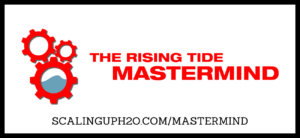 How does a high school dropout go on to earn a Ph.D. from the University Of Iowa and become the host of one of Apple Podcast’s Top 15 shows on Management? Dr. Andrew Temte‘s mission is to Teach, Coach, Mentor, and Inspire, and today, the Scaling UP! H2O podcast is honored to feature him.
How does a high school dropout go on to earn a Ph.D. from the University Of Iowa and become the host of one of Apple Podcast’s Top 15 shows on Management? Dr. Andrew Temte‘s mission is to Teach, Coach, Mentor, and Inspire, and today, the Scaling UP! H2O podcast is honored to feature him.
In this transformative interview, Andrew discusses the foundational elements of building company culture, emphasizing that it starts with leadership. He shares valuable insights on why companies should prioritize defining their purpose before diving into marketing strategies. Additionally, Andrew explores the concept of leadership as stewardship and offers guidance on identifying core values while ensuring that everyone’s voice is heard and valued.
Discover the Value of People in Business: Emphasizing the importance of supporting and empowering employees, the conversation delves into how people are the most valuable asset in any organization. The need for leaders to embrace diversity of thought and opinion to create a culture where every voice is valued is highlighted.
Explore Leadership Mindset: The transition from directive to non-directive leadership styles is discussed, emphasizing the importance of fostering an environment where diverse perspectives are welcomed and respected.
Embrace a Stewardship Mindset: Advocating for adopting a stewardship mindset as a leader, the discussion focuses on the long-term success of both the business and its people, rather than personal power or ego.
Learn about Compassionate Leadership: The concept of compassionate leadership is explored, which involves empathizing with employees and taking proactive steps to address their needs and concerns.
Key Takeaway: Discover the importance of purpose and adopting a stewardship mindset, especially in cross-generational leadership, as highlighted in this insightful conversation.
Everyone knows what it’s like to work for a horrible boss, but what could your life look like if you had a great boss – one who viewed you as the greatest asset in the company, ensured everyone’s voice was heard, and lived out the company values in their daily lives. A leader with empathy is what every team wants.
If you’re eager to enhance your leadership skills and empower yourself and your team in the water industry, join us to uncover essential insights on making your team flourish, regardless of the challenges you may face.
Timestamps
01:00 – Trace Blackmore welcomes you to the second quarter of 2024, a good time to review your goals and make a plan for the next quarter
07:00 – The Hang is coming up April 11, 2024 and Upcoming Events for Water Treatment Professionals
12:30 – Interview with Dr. Andrew Temte
48:00 – Lightning round questions
59:00 – Drop by Drop With James McDonald
Quotes
“Values and behaviors go together like peanut butter and jelly. Values are the nouns that you are creating for the overall structure of what you want your business to be. Behaviors are the verbs, they are the actions, they are the ‘how’ we should show up each day in the business. Don’t shy away from that work, engage in that work, and pay it the attention that it’s due.” – Dr. Andrew Temte
“Far too many leaders leave the business world and take all of their accumulated knowledge with them; maybe it gets disseminated to a small group of folks, maybe they do a little teaching and coaching on the side. I wanted to do something much bigger than that. I wanted to reach a much larger potential audience.” – Dr. Andrew Temte
“Go to the Gemba – where the work happens and how teams interact. Listen to the people who interact with your customers. Set your ego aside and go to where the work happens, and listen to where the work is going on.” – Dr. Andrew Temte
“As a leader, you need to create clarity. Clarity for everybody involved: your customers, your vendors, your people, your investors, your stakeholders.” – Dr. Andrew Temte
“As a compassionate leader, you need to hear the successes and the pain points across the organization.” – Dr. Andrew Temte
“Compassionate leadership is Empathy + Willingness and the ability to do something about it. You are putting yourself into the shoes of your people, and you are pledging to make their work better.” – Dr. Andrew Temte
Connect with Andrew Temte
Phone: 608.385.9050
Email: andy@skillsowl.com
Website: www.andrewtemte.com
LinkedIn: www.linkedin.com/in/atemte
Links Mentioned
Add a link to Andy’s podcast show, The Balancing Act Podcast
Listen to Episode 109 of The Balancing Act Podcast with Trace Blackmore HERE
Episode 4 with Charlie Cichetti
Scaling UP! H2O Academy video courses
AWT (Association of Water Technologies)
Books Mentioned
The Balanced Business: Building Organizational Trust and Accountability through Smooth Workflows by Andrew Temte
Balancing Act: Teach Coach Mentor Inspire by Andrew Temte
The 12 Week Year: Get More Done in 12 Weeks than Others Do in 12 Months by Brian P. Moran and Michael Lennington
What the Heck Is EOS? by Gino Wickman and Tom Bouwer
Traction: Get a Grip on Your Business by Gino Wickman
Unmanaged: Master the Magic of Creating Empowered and Happy Organizations by Jack Skeels
The NEW ROI: Return on Individuals by Dave Bookbinder
The People Side of Lean Thinking by Robert Brown
2024 Events for Water Professionals
Check out our Scaling UP! H2O Events Calendar where we’ve listed every event Water Treaters should be aware of by clicking HERE or using the dropdown menu.
Drop By Drop with James
Today’s topic is Reverse Osmosis data normalization. Over time, RO membrane performance changes. The quality and quantity of permeate water produced and the energy required to produce it will vary. In Episode 339, Jane Kucera, author of the book “Reverse Osmosis,” said, “There are six things that affect membrane performance: fouling, scaling, membrane degradation, temperature, pressure, and concentration.”
I really like that succinct list: fouling, scaling, membrane degradation, temperature, pressure, and concentration. The impacts of each of these are interrelated and complex. Changes in one of them can either hide or exasperate the effects of another. For example, dropping temperature may reduce the permeate flow rate while increasing pressure may increase it, thus canceling out the effects of each. This makes it next to impossible to determine the true performance of an RO system by simply looking at the raw data.
So, what’s the solution? If we lived in the world of scifi, we could take today’s RO membranes, put them into a time machine, activate the flux capacitor like in “Back to the Future,” travel back in time, and install those membranes in the RO machine at the same time they were started up, replaced, or even cleaned so you could measure how they would perform under the exact same conditions as the baseline. The same pressure, same temperature, and same water concentration. I keep saying the word “same,” but that is key here. How would today’s membranes perform in yesterday’s machine under the same baseline conditions? Then you could eliminate the influences of changes in temperature, pressure, and concentration and figure out the real impacts of fouling, scaling, and membrane degradation. Simple, right? Now where did we put that flux capacitor? It’s got to be around here somewhere. Oh, wait. Flux capacitors don’t actually exist yet. Dang it! Now what?
That’s where normalization comes into play. Normalization is a fancy way of saying you are going to MATHEMATICALLY take those membranes back in time and adjust for changes in temperature, pressure, and concentration. This will allow you to make an apples-to-apples comparison of permeate flows by calculating the normalized permeate flow (NPF) of today to compare to the permeate flow at the baseline conditions. The same goes for normalized pressure differential (NPD) and normalized salt rejection (NSR).
Your next logical question may be, “Well, where do I get these miraculous normalization equations?” While there are ASTM standards for such calculations, your easiest route is probably to visit your RO membrane manufacturer’s website to download their normalization tool. It may be as simple as an Excel worksheet. If you manage an RO system, it is worth your time to learn how to use these tools to normalize your RO data so you know when it is time to clean the membranes and to find problems as they occur.


